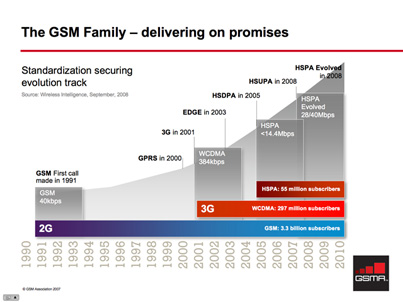M-Commerce www.gsm.org
"Mobile Commerce is an electronic transaction via the use of a mobile phone.
M-commerce allows enterprises to expand their market reach, provide better service and reduce costs.
For users, the benefits include convenience, immediacy and personalisation of each transaction.
Examples of m-commerce services today include mobile parking meter payments and the purchase of ringtones and games. Such services are known as 'micropayments': transactions with an average value of under $10."
Market development programme to accelerate the adoption of wireless connectivity in a wide range of devices.
Location-based services
Location-Based Services (LBS) provide personalised services to the user on request, based on their current position.
This could include information on nearby restaurants, hotels or other location-specific content such as maps.Cell-ID
Many LBS applications establish the location of the user by simply identifying which base station the user is currently connected to – a technique known as Cell-ID. This basic form of location tracking is supported by all GSM handsets and is accurate to an area of between 200 metres and 1 kilometre.GPS
A more advanced and accurate location technology is GPS (Global Position System). GPS uses satellites to fix the position of a mobile unit equipped to receive signals. Via satellite triangulation, a device equipped with a suitable chip can be pinpointed to its location to within a few metres.
The need for a chip inside the phone, adding to cost, weight and power requirement, made GPS a less desirable option, but better technology now makes it more attractive. GPS does, however, suffer delays (sometimes more than a minute) to get an initial fix on the location of a unit.Assisted GPS
Assisted GPS (A-GPS) systems resolve the long delay that can occur in locating a unit. Data about the mobile unit is transmitted through the network, speeding up the process to just a few seconds. This advanced technique is being introduced in new GSM handsets. A-GPS is a well-proven technique already used worldwide for the accurate tracking of valuable assets such as shipping containers and high-value loads.SMSSMS (Short Messaging Service) allows users to send and receive text messages on a mobile phone. Each message can be up to 160 characters long and sent to and from users of different operator networks. All mobile phones support SMS.
MMS
MMS (Multimedia Messaging Service) is a store and forward messaging service that allows subscribers to exchange multimedia messages.
Instant MessagingInstant Messaging (IM) is an IP-based (Internet Protocol) application that can provide real-time written communication between people using a PC or Laptop.
Wireless email is the ability to send and receive email over wireless devices. As 2.5G (GPRS) and 3GSM networks give users constant connectivity access to their email, wireless email services are expected to become increasingly popular.

